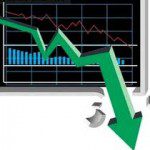What do 1929, 2000 and 2007 all have in common? Those were all years in which we saw a dramatic spike in margin debt. In all three instances, investors became highly leveraged in order to “take advantage” of a soaring stock market but, of course, we all know what happened each time. The spike in margin debt was rapidly followed by a horrifying stock market crash. Well guess what? It is happening again.
we saw a dramatic spike in margin debt. In all three instances, investors became highly leveraged in order to “take advantage” of a soaring stock market but, of course, we all know what happened each time. The spike in margin debt was rapidly followed by a horrifying stock market crash. Well guess what? It is happening again.
So writes Michael Snyder (http://theeconomiccollapseblog.com/) in edited excerpts from his original article* entitled Whenever Margin Debt Goes Over 2.25% Of GDP The Stock Market Always Crashes.
[The following article is presented by Lorimer Wilson, editor of www.munKNEE.com and may have been edited ([ ]), abridged (…) and/or reformatted (some sub-titles and bold/italics emphases) for the sake of clarity and brevity to ensure a fast and easy read. This paragraph must be included in any article re-posting to avoid copyright infringement.]
Snyder goes on to say in further edited excerpts:
In April (the last month we have a number for), margin debt rose to an all-time high… The previous high…occurred back in July 2007. Margin debt is about 29% higher than it was a year ago, and the S&P 500 has risen by more than 20% since last fall. The stock market just continues to rise even though the underlying economic fundamentals continue to get worse. So should we be alarmed? Is the stock market bubble going to burst at some point? Well, if history is any indication we are in big trouble. In the past, whenever margin debt has gone over 2.25% of GDP the stock market has crashed. That certainly does not mean that the market is going to crash this week, but it is a major red flag.
The funny thing is that the fact that investors are so highly leveraged is being seen as a positive thing by many in the financial world. Some believe that a high level of margin debt is a sign that “investor confidence” is high and that the rally will continue. The following is from a recent article in the Wall Street Journal…
The rising level of debt is seen as a measure of investor confidence, as investors are more willing to take out debt against investments when shares are rising and they have more value in their portfolios to borrow against. The latest rise has been fueled by low interest rates and a 15% year-to-date stock-market rally.
Others, however, consider the spike in margin debt to be a very ominous sign. Margin debt has now risen to about 2.4% of GDP, and as the New York Times recently pointed out, whenever we have gotten this high before a market crash has always followed…
The first time in recent decades that total margin debt exceeded 2.25 percent of G.D.P. came at the end of 1999, amid the technology stock bubble. Margin debt fell after that bubble burst, but began to rise again during the housing boom — when anecdotal evidence said some investors were using their investments to secure loans that went for down payments on homes. That boom in margin loans also ended badly.
Posted below is a chart of the performance of the S&P 500 over the last several decades. After looking at this chart, compare it to the margin debt charts that the New York Times recently published that you can find right here. There is a very strong correlation between these charts. You can find some more charts that directly compare the level of margin debt and the performance of the S&P 500 right here. Every time margin debt has soared to a dramatic new high in the past, a stock market crash and a recession have always followed. Will we escape a similar fate this time?
What makes all of this even more alarming is the fact that a number of things that we have not seen happen in the U.S. economy since 2009 are starting to happen again. For much more on this, please see my previous article entitled “12 Clear Signals That The U.S. Economy Is About To Really Slow Down“. At some point the stock market will catch up with the economy. When that happens, it will probably happen very rapidly and a lot of people will lose a lot of money.
There are certainly a lot of prominent voices out there that are warning about what is coming. For example, the following is what renowned investor Alan M. Newman had to say about the current state of the market earlier this year…
“If anything has changed yet in 2013, we certainly do not see it. Despite the early post-fiscal cliff rally, this is the same beast we rode to the 2007 highs for the Dow Industrials. The U.S. stock market is over leveraged, overpriced and has been commandeered by mechanical forces to such an extent that all holding periods are now affected by more risk than at any time in history.”
Unfortunately, most Americans never get to hear such voices. Instead, most Americans rely on the mainstream media to do much of their thinking for them and right now the mainstream media is insisting that we are not in a stock market bubble…
Forbes: “Why Stocks Are On Solid Footing And This Is No Bubble”
ABC News: “AP Survey: Economists See No Stock Market Bubble”
Businessweek: “Prognostications: It’s Not a Stock Bubble”
Yahoo: “This Is NOT a Stock Bubble! Says Ben Stein”
MarketWatch: “Is a stock bubble coming? No, say economists”
[Then there is the multitude of articles on the web (as posted on munKNEE.com) suggesting the exact same thing:1. Stock Market Could Enjoy Many More Years of Big Gains! Here’s Why
2. Easy Money Is To Be Had: Buy the DOW – Now!
3. The Stock Market: There’s NOTHING to Be Bearish About – Take a Look
4. Relax ! Stocks Are In NO Immediate Danger – Here’s Why
5. Latest Action Suggests Stock Market Beginning a New Long-term Bull Market – Here’s Why
6. Sorry Bears – The Facts Show That the U.S. Recovery Is Legit – Here’s Why
7. Stocks Are NOT In Another Bubble – Here’s Why
8. Research Says Stock Market Bull Should Continue Its Run Until…
10. Bull Market in Stocks Isn’t About to End Anytime Soon! Here’s Why
11. QE Could Drive S&P 500 UP 25% in 2013 & UP Another 28% in 2014 – Here’s Why
12. 5 Reasons To Be Positive On Equities
13. Start Investing In Equities – Your Future Self May Thank You. Here’s Why
14. Investors, Get Fully Invested! S&P 500 On Verge of Entering Euphoria Stage of Cyclical Bull Market
15. What Does Stock Market Valuation Multiple Suggests for Future of S&P 500?]
What do you think? Do you believe that we are in a stock market bubble that is about to burst, or do you believe that everything is going to be just fine?
Please feel free to express your opinion by posting a comment below…
[Editor’s Note: The author’s views and conclusions in the above article are unaltered and no personal comments have been included to maintain the integrity of the original post. Furthermore, the views, conclusions and any recommendations offered in this article are not to be construed as an endorsement of such by the editor.]
*http://theeconomiccollapseblog.com/archives/whenever-margin-debt-goes-over-2-25-of-gdp-the-stock-market-always-crashes
Related Articles:
1. Level of Investor Margin Suggest Its Time to Lower Stock Exposure
Some times in history, investors feel so confident about the future of stocks, they actually use up all their available cash and then borrow money to invest in the stock market. Now is one of those times – and it suggests that now is the time to lower one’s stock exposure. Here’s why. Read More »
2. S&P 500′s PEG Ratio Suggests Overvaluation & Coming Correction
The S&P 500 index is trading at record high levels and optimism remains high with Barron’s professional money manager survey indicating a record 74% money managers being bullish on markets even at current levels. [When one] measures valuations with respect to expected growth, [however, the ensuing ratio, the PEG ratio,] suggests overvaluation at these levels. [Let me explain further.] Words: 254; Charts: 1 Read More »
3. It’s Time to Apply the “Greater Fool Theory” and Sell Your Winners to All Those Fools
The Dow has surpassed its all-time record high – set in October 2007 – and the S&P 500 is not far behind? Is this the early stage of another great bull market? Let’s look back at the two previous times when the S&P 500 set new all-time highs and see if we can learn something. Wait…first put your “this time it’s different” glasses on. OK, let’s go. Words: 430; Charts: 1
4. Don’t Ignore This Fact: “Greedometer Gauge” Signals S&P 500 Drop to the 500s by July-August, 2013!
The S&P500 is likely to achieve a secular (long term) peak this month, then drop to the 500s by July-August 2013. This article explains why. Words: 180
5. This Metric Strongly Suggests a Major Correction in the S&P 500 Could Be Coming
History shows that when investors experience a rapid decline in the amount of available cash in their brokerage account to spend/invest quickly such “negative net worth” leads to major corrections in the stock market. Currently such is the case so can we expect another such decline or will it be different this time?
6. Watch Out For Falling Stocks! Here’s Why
The stock markets make no sense. They have literally lost touch with reality. Divergences between fundamentals, confidence and the valuation of markets are large [and, as such,] cannot last for long….The only question is how…and how quickly….this correction occurs. Words: 261
7. You Need to Stay in the Stock Market Despite an Impending Economic Collapse – Here’s Why
You need to stay in markets despite an impending economic collapse. [Really?! Yes, really.] Normally such an expectation would be addressed by getting out of the way of the oncoming disaster and taking ones chips off the table [but,] in this situation, there is no place to hide. Low-risk assets, like bonds and near-cash, produce little to no return…and the threat of rising interest rates and inflation make them dangerous. Higher risk assets are unavoidable, given current conditions. [Let me explain further.] Words: 830
8. You Can Insure Your Portfolio From Potential Capital Loss – Here’s How
Most everything you’ve heard about investing from the mainstream media, your mutual fund advisor and your tax accountant is a lie. You’ve been told…that the entire point of portfolio diversification is to mitigate downside risk yet when the market experiences the inevitable decline, every sector pushes significantly lower – and your “diversified” portfolio suffers as a result, [right? Well, there IS a better way.] Hear me out. Words: 895
9. The U.S. Stock Market Is Overvalued By More Than 50%! Here’s Why
Key stock indices are becoming significantly overpriced. The value of the U.S. stock market stands at about 133% of GDP. The average for the past 60 years has been around 82%. By this measure, the U.S. stock market is overvalued by more than 50%! Words: 398
10. Stop! Don’t Forget Market Risk – Remember What Happened in 2000 & 2007/8.
Investors are more bullish now than at any time since 2002 but the current rally has not been fueled by improved prospects of actual growth and wealth creation. Instead, it’s mostly due to:
- investors desperate for income denied them elsewhere by central bank policies;
- printed stimulus cash seeking a home and
- sheer technical momentum
but nowhere do they seem to be considering market risk – the risk that your investment will lose value because it gets dragged down in a falling market. Words: 615
11. Insider Trading Suggests That a Market Crash Is Coming
What you are about to read below is startling. •Every time that the market has fallen in recent years, insiders have been able to get out ahead of time… •[What] is so alarming [this time round is] that corporate insiders are selling nine times as many shares as they are buying right now. •In addition, some extraordinarily large bets have just been made that will only pay off if the financial markets in the U.S. crash by the end of April. •So what does all of this mean? [Could it be that they] have insider knowledge that a market crash is coming? Evaluate the evidence below and decide for yourself. Words: 570
12. Ignore Wall Street Cheerleaders: Market Technicals, Fundamentals & Other Info Says Otherwise!
[In spite of what] the typical Wall Street cheerleaders, I mean strategists, are predicting, we see the equity market ever more closer to its cyclical top, miners about to retest a major bottom and hard assets with a new catalyst. [This article analyzes 9 pieces of information, complete with charts, that show what is actually going on in the marketplace at this point in time and what the short-term future holds.] Words: 930; Charts: 813. 5 Sound Reasons Investors Would Be Better Off On the Sidelines Than In the Market
New year festivities have continued on the stock market even as the Christmas trees have been put away. The “death of the fiscal cliff,” not horrible job numbers and supportive comments from Mario Draghi on the other side of the pond have led to bold and bullish behaviors over the last three weeks. While no one can predict the exact peak, here are five reasons you’re better off on the sidelines than in the market.
14. These Charts Suggest a Possible +/-60% Decline in the S&P 500 by 2014
J.P. Morgan Asset Management has developed a chart showing the past two cycles in the S&P 500 highlighting peak and trough valuations. At face value it is very alarming as it suggests a potential decline of somewhere in the vicinity of 60% over the next year or two and concurs with previous innovative trend analyses included in this article. Charts: 4
Based on the latest S&P 500 monthly data, [my analyses indicate that] the market is overvalued somewhere in the range of 33% to 51%, depending on which of 4 indicators I used. This is an increase over the previous month’s 31% to 48% range. [Let me explain the details.] Words: 475
15. Goldman Sachs’ Leading Indicators Signal Steep Market Crash Ahead
Mark Spitznagel…warned the other day that the S&P 500 could lose 40% of its value in the next couple of years. So what black swan event could cause the S&P 500 to drop down to 760? [Let’s take a closer look.] Words: 856
16. Is the U.S. Stock Market Topping & About to Plunge?
Many signs point to a plunge for the Dow Jones Industrial Average and major indexes rather than a continued climb. If history is ever a good indicator of forthcoming events, it is absolutely imperative that we pay attentions to these signs, and prepare for the worst. Here are a few reasons why the Major U.S stock indexes could see declines in the coming months. Read More »
17. What Are the “Titanic Syndrome” & “Hindenburg Omen”? What Are They Now Saying?
There are two market warning signs which have just recently been triggered and which have gotten a lot of press attention due to their catchy names – the Titanic Syndrome and the Hindenburg Omen – both of which are giving a “preliminary sell signal” based on analyses of 52-week New Lows (NL) in relation to New Highs (NH) on the NYSE within a specific period of time. Read More »
18. History Suggests Dow Has Only 4% More To Go Before Correcting
19. Latest Stock Valuation Table Says What About U.S. Market Levels?
The GNP numbers came out this week for the first quarter of 2013 and there was 1.8% growth yoy to $16.236 trillion…What does this mean to your equity positioning? Read More »
 munKNEE.com Your Key to Making Money
munKNEE.com Your Key to Making Money


